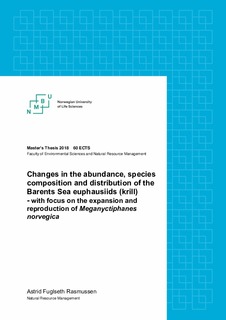| dc.description.abstract | Euphausiids (krill) play a key role in the Barents Sea ecosystem, being an important prey for a number of species, and thereby transferring energy from primary producers to higher trophic levels. An unprecedented warming is currently happening in the Barents Sea, diminishing sea ice and affecting the distribution of water masses. As the Barents Sea environment is changing quickly, it crucial to estimate how euphausiid populations will be affected by climate change. The four main species of euphausiids in the Barents Sea are Thysanoeassa inermis, T. longicaudata, T. raschii and Meganyctiphanes norvegica. The goal of this thesis was to establish the relative species composition, distribution and abundance of the four main euphausiid species in the warm years of 2007-2015. For a reference, the results were compared with data collected in a colder period, during the years 1984-1992. Furthermore, an important part of understanding euphausiid population dynamics is the reproductive cycle. Therefore, this study also investigated the species composition, development and distribution of larvae in the southwestern Barents Sea, May 2015, and sought to compare these to investigations undertaken in 1988 and 1989 (Loftnes, 1993). My results show that there was a significant difference in the total abundance of euphausiids between the two study periods 1984-1992 and 2007-2015, having more than doubled from the first to the second, despite high capelin predation. Total euphausiid abundance was mainly distributed in the southwestern and south-central parts of the Barents Sea, south of 75°N in both study periods. However, T. inermis, T. longicaudata and the boreal, North-Atlantic species M. norvegica seemed to extend their distributional ranges into the northern parts of the Barents Sea during the years 2007-2015. Moreover, the abundance of M. norvegica increased from the first to the second study period, constituting a significant part of the species composition in the years 2007-2015. In contrast, abundances of the cold-water species T. raschii was significantly lower in the second study period. The distribution and species composition of euphausiid larvae of May 2015 were very similar to what was found in June 1988 and May 1989 with the largest abundances of larvae found in the Atlantic waters south of Bear Island, and the majority of larvae belonging to T. inermis. The spawning and development of larvae seemed to be related to water mass, being further developed in Coastal and Atlantic waters. Larvae of M norvegica were only found at the southernmost stations, indicating that there is still a thermal constraint on the reproduction of this species in the Barents Sea. However, if the warming continues, M. norvegica has the potential of completing a full life cycle in Barents Sea waters, which would highlight the ongoing Atlantification of the Barents Sea ecosystem. | nb_NO |

